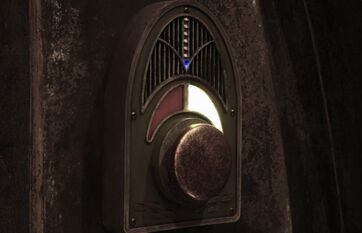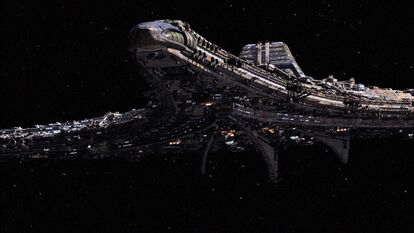- "The design is clearly Ancient, in the truest sense of the word. Launched hundreds of thousands of years ago. Faster than light, yet not through hyperspace. Who knows how far it's traveled."
- ―Nicholas Rush
Destiny is a ship in the Ancient fleet, constructed and launched around 60 million years ago from Earth.[5] The Ancients launched several automated ships prior to Destiny, each with the purpose of constructing and seeding Stargates throughout the numerous galaxies they crossed, with Destiny itself planned to followed in their path to explore those planets.
After beginning this process, the Ancients initially planned to wait until the ship reached a sufficient distance from Earth to board it. However, other endeavors—such as Ascension—prevented them from following through on the plan. Because of this, Destiny has continued on a pre-programmed path on its journey throughout the stars, alone, for millions of years. With the arrival of a Tau'ri expedition in 2009, Destiny has a new crew.
Specifications
- "It is spectacular, isn't it?"
- ―David Telford
Destiny itself is relatively flat and triangular in shape. The left and right sides are markedly concave, while the aft portion of the ship is convexly rounded. The ship is very long and becomes more narrow towards the bow. The surface of the ship is covered with layers of textural elements, including a large number of triple-barreled weapon turrets and anti-fighter emplacements.
Some doors in Destiny's interior are accompanied by a small control panel, much like Atlantis has panels containing Control crystals that control some of the doors there. The small blue light on a door panel indicates it is on automatic. Beneath that, the red and amber lights indicate whether the door is locked or unlocked, respectively. Below the large round button, along the bottom of the panel—are eight small buttons with ancient writing on them that allow for manual overrides or door code changes.
Destiny is capable of faster than light travel (FTL) but not by means of hyperdrive engines. The FTL drive spans the full rear of the ship.
It predates the Ancient Technology Activation gene security feature featured in the outposts and in Lantean technology, instead having an incredibly complex master code based on an advanced Ancient DNA sequence. This access code is required for access to systems such as navigation and advanced power management, but not for basic weapon and shield control.
History
- "This ship was launched to solve a mystery, not by arriving at some ultimate destination where all the questions are answered at one time, but by accumulating knowledge bit by bit."
- ―Nicholas Rush
A small portion of Destiny's 60 million-year-old flightpath.
Not long after the creation of the Stargates, the Ancients discovered a pattern in the Cosmic microwave background radiation; recognizing that the pattern could not have been natural in origin, the Ancients concluded that its presence suggested an order to the universe never thought possible, possibly some kind of message. However, the message was fragmented and could not be recovered. To that end, they devoted the efforts of an entire generation to the construction of Destiny, the purpose of which was to find and reassemble the fragments, completing the message. Automated ships were sent ahead of Destiny to explore the universe, seeding Stargates along their path. It was their intention to further their knowledge of the Universe, but they abandoned the project as they started researching into Ascension. Nonetheless, Destiny continued to go from planet to planet, system to system, galaxy to galaxy for millions of years.
Over its long journey, Destiny has sustained significant damage. Though some of the damage is simply neglect (as the ship has been left unmanned far longer than intended), battle damage is also evident, shown by the numerous hull breaches. Destiny's shields automatically compensate by sealing off the breaches with forcefields; however, the shielding is insufficient for the larger breaches and bulkheads were automatically closed and locked to compensate. (SGU: "Air, Part 1")
2009
Destiny approaches a star to recharge.
In early 2009, the personnel of the Icarus project managed to unlock the Stargate's ninth chevron. At the same time, Icarus Base came under attack by the Lucian Alliance, forcing them to evacuate through the gate to Destiny. When the Tau'ri arrived, most of the ship was either damaged or inaccessible. The ship's power and oxygen levels were also running low. The crew managed to repair the filtration system, keeping themselves alive. After the ship solved its power issues by diving into a sun to recharge, they discovered that a dust creature had affected and was draining their water supply, forcing them to salvage water from a nearby ice planet in order to sustain themselves. (SGU: "Air, Part 1", "Air, Part 3", "Darkness", "Light", "Water")
A short time into their journey, the expedition came into conflict with a race called the Nakai, who had been chasing the ship for a long time in an attempt to uncover its secrets. Since then, the crew has had to fend off numerous attacks by the aliens, although Destiny's own defences have proven sufficent to sustain them despite its decades of damage. During its trip between galaxies, the Nakai managed to sabotage Destiny's Faster-Than-Light engine, which required the crew to remove one of the units from the drive section and bypass it. Ironically, the damaged unit was hampering the overall efficiency of the drive, and had the aliens not destroyed it, Destiny would have never been able to make it to the next galaxy within the crew's lifetime. (SGU: "Space", "Divided", "Sabotage")
Destiny docked with a seed ship.
Following the Lucian Alliance invasion of Destiny, Dr. Nicholas Rush discovered the ship's bridge, along with information about its mission. However, he attempted to conceal this information in the belief that nobody else in the crew would be able to understand the implications of his discovery, resulting in the death of Sgt. Hunter Riley when Rush programmed Destiny to stop near a planet with a damaged Stargate and later stranding Colonel David Telford after disconnecting Destiny from a Seed ship that could have provided them with power to re-dial Earth (albeit after the unknown aliens living on the ship tried to drain power from Destiny), the crew only learning about his control of Destiny when he departed the ship to try and kill the Lucian Alliance member Simeon after Simeon killed Dr. Amanda Perry—as well as her "host", former Lucian Alliance member Ginn—while the two were using the Long-range communication stones. (SGU: "Aftermath", "Awakening", "The Greater Good")
Attack drones overwhelm Destiny.
With the crew now able to control Destiny's flight path after Rush was forced to reveal his discovery of the bridge, they diverted the ship to investigate a strange signal, only to find themselves caught in a fight between the aliens met on the Seed ship—now identified as the Ursini—and another unknown alien race that Destiny only survived thanks to the timely intervention of the returned Colonel Telford in the seed ship, only to subsequently find themselves locked in battle with the Control Ship after the Ursini took Destiny to confront it ahead of schedule. Fortunately, the intervention of the Nakai—summoned by Chloe Armstrong using her pathogen-based connection to them—bought Destiny enough time to take out the command ship. The Ursini attempted to contact their colony, only to draw the attention of a second command ship. The Ursini subsequently sacrificed themselves and their seed ship to give the Destiny crew enough time to repair the damage Destiny had sustained to its shield and FTL systems in the fight and jump out of harm's way. (SGU: "Pathogen", "Resurgence", "Deliverance")
2010
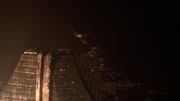
Destiny approaches its other self
Given the amount of damage the ship had sustained recently, Colonel David Telford attempted to convince them to attempt to dial Earth while Destiny was charging inside a star, only for this attempt to be interrupted by the arrival of a future version of Dr. Nicholas Rush, who revealed that his version of Destiny had attempted Telford's plan, which ended in disaster. In attempting to dial Earth, Destiny was thrown back in time 12 hours. Telford survived the trip through the wormhole, but the others were believed to have died. The crew were able to salvage parts from the future Destiny, including a second Ancient shuttle flown by the future Rush, to repair the current Destiny. Future Rush and present Telford were both lost during the mission. Telford died when Rush accidentally pushed him into a live power relay, while Rush allowed himself to die aboard the future Destiny while using the Destiny interface chair. (SGU: "Twin Destinies")
After Earth was attacked by the Lucian Alliance, communication via the Long-range communication device was temporarily cut off. When a connection was made and the consciousness' of Ginn and Dr. Amanda Perry were in Chloe Armstrong's body, the two consciousness were transferred into Destiny's memory banks. They existed as interactive programs but were later quarantined by Eli Wallace after Dr. Rush's consciousness became trapped in a simulation through the control chair created by Perry. (SGU: "Hope", "Seizure")
When the CO2 scrubber's on the ship began to lose efficiency, the ship was attacked by Berzerker drone's again. The ship manages to flee. When the crew stops the ship again to gather supplies, they encounter the People of Novus on one of their colonies. The people are descendents from the expedition that arrived 2,000 years previously as a result of their previous attempt to dial in a star. The crew's homeworld of Novus grew from a rudimentary population into an advanced civilization. The colony was cut off from their homeworld and following an attack by the drones on both the planet and the ship, they returned the colonists to their world. They found the world abandoned, the population having launched in ships towards their near by colony. The expedition crew gathered supplies from the planet, including a CO2 scrubber substance that would work for years to come. The crew also gained a third of the Tenaran archive contained in a bunker. The planet was abandoned by the colonists and the crew when the last city was destroyed. The expedition crew dropped the colonists off on the colony ten days later. (SGU: "Common Descent", "Epilogue")
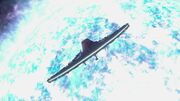
Destiny dives into the blue giant to recharge
Sometime after the crew dropped the colonists off, the ship performed an Aerobraking maneuver prior to recharging. It was discovered after two attempts that the drones were blockading stars. The crew, save Rush, Eli and Dr. Lisa Park, took up residence on a colony while the ship recharged in a blue supergiant. The ship recharged, but the garden dome was breached in the process. (SGU: "Blockade")
Needing to resupply, the crew modified Destiny's shields and then launched an attack on a Control Ship that was blockading one of the planets along the ship's course and succeded in destroying it, but got very little in the way of supplies and Destiny was damaged by suicide runs employed by the drones. Needing another plan and without hope of resupply from Earth, the crew decided to enter Stasis pods and have Destiny skip the rest of the galaxy and travel to the next in one long jump with the crew in stasis. After engaging the drones again to get the palladium hydride needed to repair eight of the stasis pods, all of the crew except Eli Wallace entered stasis; Eli remained behind to try to fix the remaining pod in the two weeks he had before Destiny could not spare the power anymore. (SGU: "Gauntlet")
Technology
- "This ship... It's a source of untold power?
No, no, not literally. It's more to do with what it's doing. The information it's capable of gathering." - ―Eli Wallace and Nicholas Rush[7]
The Destiny has a great deal of advanced technology at her disposal, ranging from the Stargate and Shuttles, to energy weapons, the Faster-Than-Light engine, to the solar power collectors and the all-important energy shields.
Power generation
- "The ship is powered by the stars themselves. Solar powered - quite literally. There is no other explanation."
- ―Nicholas Rush
Destiny's solar power collectors.
Destiny reactors are fueled by absorbing and storing stellar material through a series of ram scoops on the underside of each wing. To accomplish this, Destiny dives into the photosphere of a star, absorbing material during its fly-through. The shields allow matter to pass through for the ram scoops to collect while keeping the ship completely protected from the intense conditions. However, large, hot stars (such as Blue giants) are more than Destinys's protective capabilities can fully handle. Destiny can still use these stars to recharge though not without incurring some degree of damage and putting great strain on its shields. The ship will perform this recharging process automatically whenever power levels drop below a certain point. The ram scoops will also apparently engage at any available opportunity, such as when Destiny followed a seed ship through a star to destroy a group of attacking berzerker drones.
During its recharge cycle, Destiny has a theoretically limitless amount of power, since power is replenished almost as quickly as it can be expended. The International Oversight Advisory devised a plan to use this recharge cycle to dial Earth with the Stargate. However, this plan is fraught with danger, and the only two attempts thus far have ended in failure (though the first was sabotaged, it likely would not have succeeded anyway). Due to the age of the ship, Destiny can only reach approximately 40% of its originally-designed power capacity when recharging, although so far the only noticeable result of this power shortage is the ship's inability to dial a nine-chevron address, with other functions such as life support and weapons operating relatively normally. (Albeit most likely operating at a lesser efficiency than they would have done when the ship was completely new). (SGU: "Air, Part 2", "Darkness", "Light", "Water", "Earth", "Resurgence", "Twin Destinies")
Shields
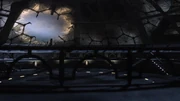
Destiny's energy shield in a damaged area.
- "They're gonna realise they can't get past the shields and they're gonna give up."
- ―Nicholas Rush
Destiny possesses a yellow energy shielding system which may be localized to retain the atmosphere in damaged parts of the ships. However, shield strength is dependent on power levels and the number of localized shields currently active. Destiny's shields are capable of resisting the intense heat and turbulence of a star's corona, using only reserve power, to the point where neither is at all noticeable to anyone inside. They were rapidly depleted by energy weapons during a battle with the Nakai, though this is most likely due to a power transfer problem rather than a less advanced design, as damage to defensive systems is very significant and most of the ship is not operational. Both shields and weapons might get their power from the same source at the moment due to damaged relays, and so the ship may have automatically diverted more power to one and less to the other to keep it balanced to allow both to run at the same time. The shield strength can also be attenuated to allow things to pass through them. (SGU: "Light", "Earth", "Space", "Incursion, Part 2")
Destiny's shields holding under fire.
After further progression of Tau'ri repairs to the ship, according to a simulation performed by the ship's computers, its shields are now able to resist fire for over 44 minutes from nine Nakai motherships. It is likely that even this does not represent the full capabilities of the ship when it was first launched, as it still suffers from extensive damage. (SGU: "Trial and Error")
Destiny's shields are capable of protecting the ship while flying through an O-class star, although the interior of the ship will get past 300 C in the process. This does not seem to damage the ship's systems, but the crew were forced to temporarily evacuate the ship to ensure that they were not killed by the heat, the ship being temporarily manned by a three-person crew using the Ancient space suits. (SGU: "Blockade")
Destiny's shields constantly change frequencies in the hope of matching enemy fire; the closer the frequency, the less damage Destiny takes. While this makes the shields less effective against specific types of energy weapons, it provides better general protection overall. However, Destiny's programming can be overwridden to allow the shields to be set to a specific frequency (or close to it) to provide better protection against that specific type of energy weapon. Unfortunately, doing so leaves the ship vulnerable to all other types of attacks.(SGU: "Gauntlet")
Since the Tau'ri crew came on board, Destiny has only taken hits from what appears to be low to mid-level energy weapons, which has put its shield under strain to the point of failure on numerous occassions (the ship is very old and damaged, however). Although speculative, extremely advanced and powerful energy weapons, such as the Asgard plasma beams, would probably not only deplete Destiny's shield, but penetrate it and tear the ship apart.
Weapons
Destiny firing its anti-fighter turrets.
- "That's the way it's been for a long time, Eli. They attack, they try and get on board, the ship's automated defences stop ‘em."
- ―Nicholas Rush
Destiny possesses a vast array of yellow energy weapons, which is comprised of a large number of double-barreled weapon turrets located all along the ship's hull. These turrets appear to be anti-fighter weapons, capable of rapid-fire and tracking to destroy smaller ships. Given enough time and under the right circumstances, they are capable of greatly diminishing Destiny's power reserves. The weapons draw power from the shields while active, diminishing defence in favor of offense. However this could be because most of the ship is not operational, suggesting that it might not be a power problem but a power transfer problem. (SGU: "Earth", "Space")
Destiny is also equipped with four larger energy cannons located on the underside of the hull. Capable of significantly stronger blasts than her standard weapons, these cannons are designed for use against larger vessels such as motherships. Like the standard weapons, Destiny's energy cannons run the risk of depleting the ship's power reserves, and can even cause the weapons systems to overload if used in excess, which can destroy the ship. This is most likely due to the damage the ship has taken over its journey. Destiny's main weapon appears to be capable of destroying a berzerker drone command ship with only a few shots, although a Nakai ship's shields can resist more firepower. (SGU: "Earth", "Space", "Deliverance")
Faster-Than-Light engine
- "Faster than light, yet not through hyperspace."
- ―Nicholas Rush
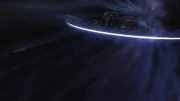
Destiny's engines.
Destiny's Faster-Than-Light engine, or FTL engine, is capable of faster-than-light travel without entering hyperspace. An incoming wormhole to the ship's Stargate will trigger the drive to temporarily shut down, enabling the gate to connect. Destiny had 16 individual FTL engine units, but now only has 15 after a damaged one was removed. The drive can operate normally using only fifteen or perhaps even fewer. So long as shields are enveloping both ships, other ships can jump into FTL while attached to Destiny, but they must be securely attached to the ship—such as via the shuttle docking clamps—or they may be ripped apart by the resulting stresses When entering and exiting FTL, it disrupts the long-range communication device for a few seconds. Unexpected anomalies—such as the gravitational pull from an uncharted star—can cause Destiny to drop out of FTL; but the automated navigational systems can adjust the Destiny's course using sublight engines to prevent a collision and get back on course to engage FTL again once clear. The FTL engines must remain active for four hours after a jump and inactive for three hours when they are disengaged. Jumps made earlier than this can cause damage to the engine. (SGU: "Divided", "Faith", "Sabotage", "Aftermath", "Resurgence")
Stargate
- "Isn't it something? Rush figures that this gate predates all the others we know of, like a prototype. It's the only way we're ever going to get home."
- ―Eli Wallace[8]
The Stargate aboard the Destiny is a different, older design from the Stargates seen in the Milky Way and Pegasus galaxies. According to Dr. Nicholas Rush, the Stargate aboard Destiny is among the first of the Stargates ever created. Furthermore, the Stargate aboard Destiny is the same design as those constructed and distributed by Seed ships across the universe, being slightly smaller than its successors. (SGU: "Air, Part 3")
Destiny's Stargate activates.
Because the entirety of Destiny's gate spins rather than just the inner ring, the chevrons spin as well and therefore the addresses do not line up with the chevrons to lock. The chevrons, merely function as indicators, lighting upon powering of the gate. Instead, the gate spins clockwise until the first glyph is positioned right underneath the Gate bearing, at the topmost position. The Gate then changes direction, spinning counter-clockwise until the the next glyph is locked. This alternating process is repeated until the point-of-origin glyph is locked and the wormhole forms. The orb at the end of the bearing lights up briefly as each address glyph on the Gate locks directly below it. Once the wormhole is formed, the gate bearing remains lit while the gate is active, as does a final chevron in the floor. The wormhole texture of this gate type also appears different, being silvery and darker at the edges. As the wormhole disengages and the Stargate shuts down, all lights turn off at the same time. This is followed by a several second blast of CO2 from vents on either side of the gate. (SGU: "Air, Part 1")
Different aspects
Locations
- Bridge
- Brody's bar
- Communication lab
- Control interface room
- Crew quarters
- Garden
- Gate room
- Holding area
- Hydroponics lab
- Infirmary
- Kino room
- Mess hall
- Observation deck
- Research lab
- Showers
- Stasis hall
- Water storage room
- Workout room
- Armory
Technology
- Artificial Intelligence
- Ancient maintenance robot
- CO2 scrubber
- Control interface hub
- Database
- Docking clamps
- Elevators
- Energy shields
- Faster-Than-Light engine
- Hubs
- Interface chair
- Jump countdown
- Kino
- Long-range communication device
- Destiny neural link
- Power Relay
- Recharging plate
- Shield emitter
- Solar power collectors
- Stargate
- Stasis pods
Crew
- Main article: Destiny expedition
- "We're going to have to be tough, disciplined. The road may be longer than many of us hoped. We will have to sacrifice, compromise, work together without exceptions. We are going to survive. We are going to make it home. Make no mistake."
- ―Everett Young
Senior staff
- Colonel Everett Young (Expedition Leader and Military Commander)
- Lt. Matthew Scott (Temporary Military Commander)
- Dr. Nicholas Rush (Senior Scientist)
- IOA Camile Wray (IOA official and Civilian contingent)
- Lt. Tamara Johansen (Chief Medical Officer)
Alternate Versions

Destruction of the Destiny
- In an alternate timeline, the crew attempted to create a wormhole back to Earth by dialing the Stargate while Destiny was charging inside a star, causing a temporal event, sending this Destiny twelve hours into the past. Colonel David Telford made it through to Earth, but a second solar flare threw the rest of the crew, except Dr. Nicholas Rush, back in time 2,000 years. The Nicholas Rush of this Destiny was able to explain the situation to the crew, who subsequently salvaged parts from the other Destiny to repair their own version. This Destiny ultimately fell into the star and disintegrated. (SGU: "Twin Destinies")
Gallery
References
- ↑ 1.0 1.1 Stargate Magazine #32, Jan/Feb issue, page 84. Please note: The size measurements given in Stargate Magazine #32 do not appear to be correctly scaled. The ship should be at least twice as long as it is wide.
- ↑ "Sabotage" Episode.
- ↑ "Air, Part 1" contains the gate address. Please note that only the first, seventh, and ninth are confirmed to be in order. (Some were seen on a DHD)
- ↑ "Lost" contains the gate address.
- ↑ July 19, 2010: Masked hits the street! Last days of Atlantis! Mailbag! on Joseph Mallozzi's Weblog
- ↑ Gauntlet
- ↑ "Air, Part 2" (Extended version)
- ↑ The Stargate Room
External links
- GateWorld's article on Destiny in The Stargate Omnipedia
- Destiny on Wikipedia




